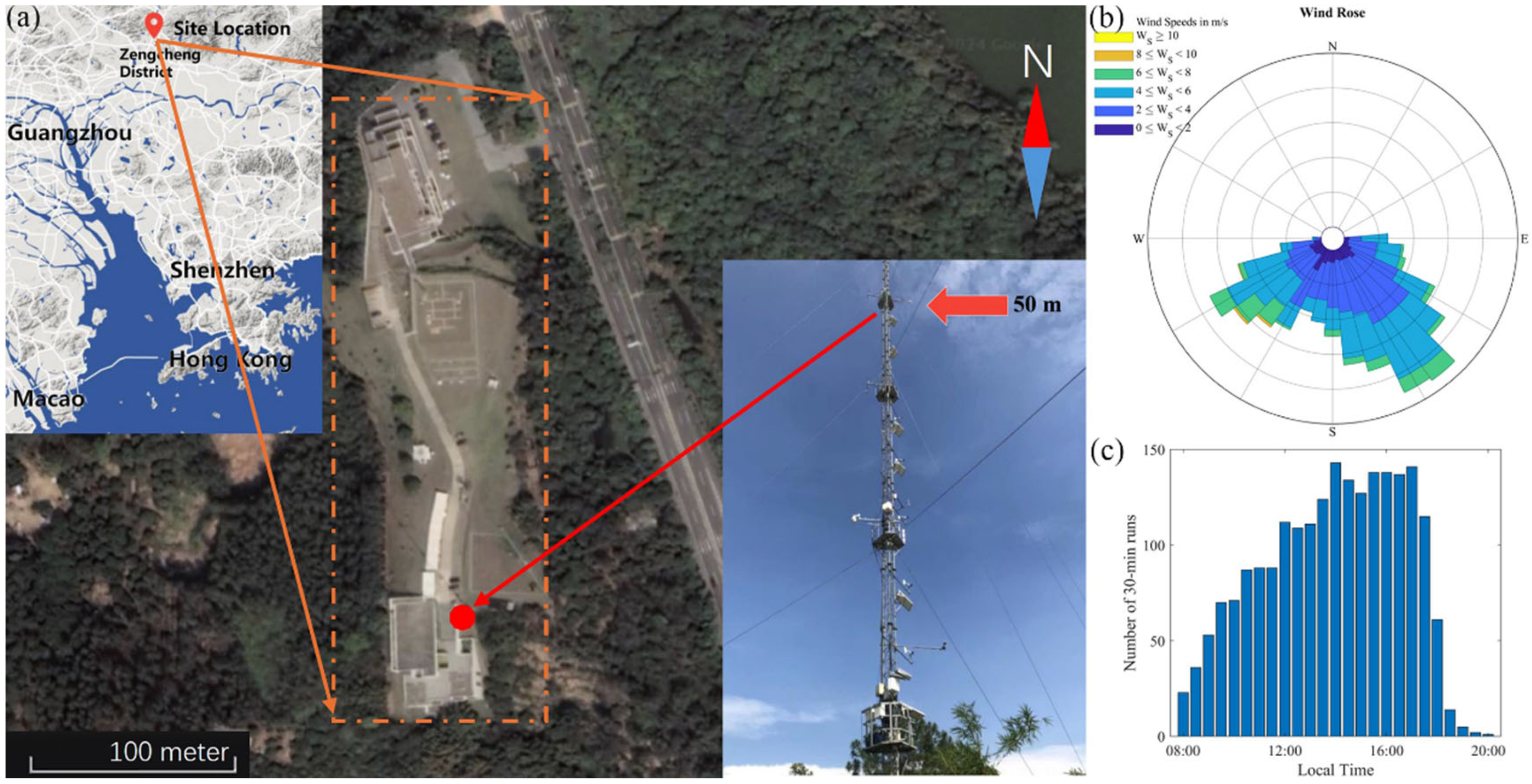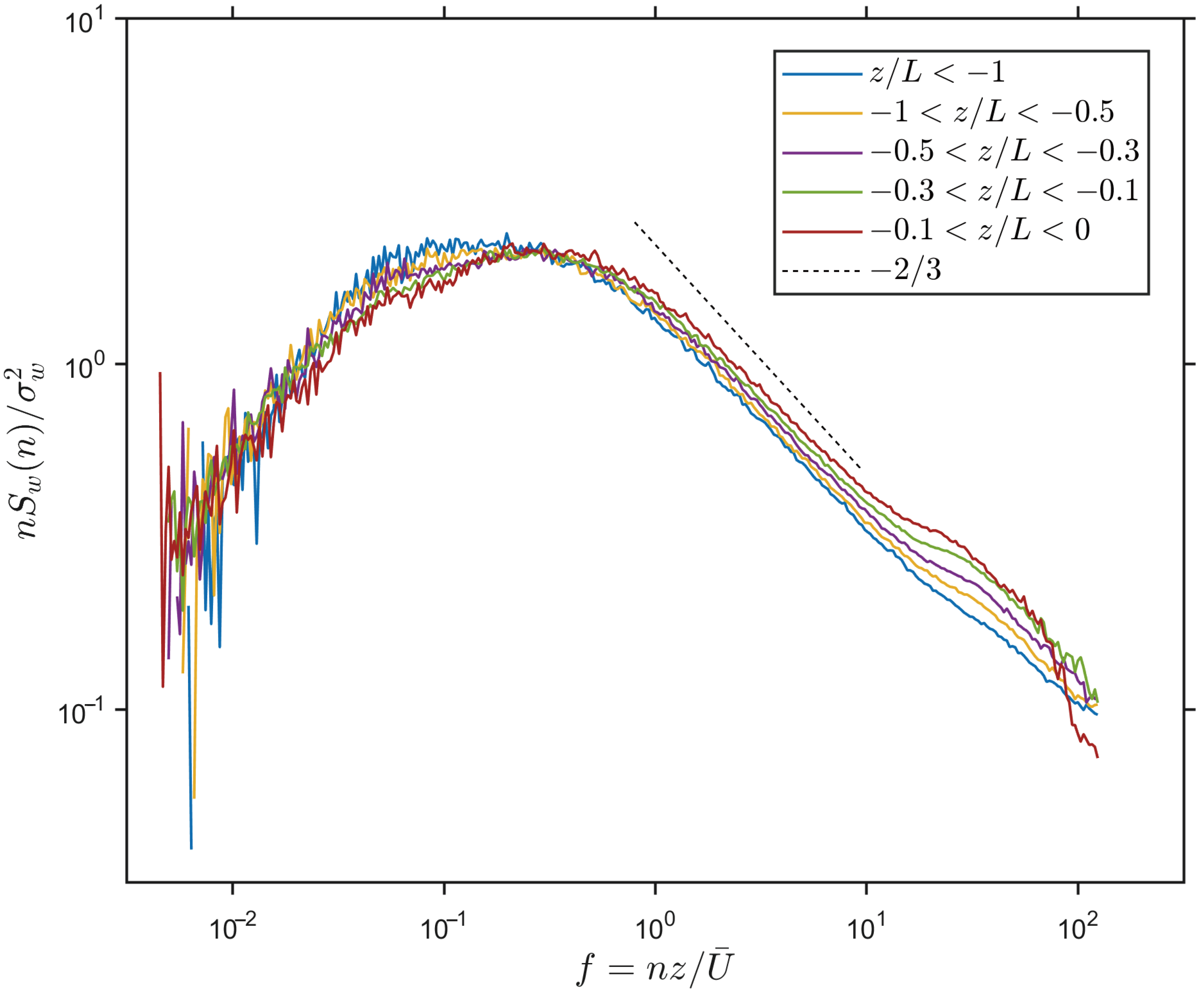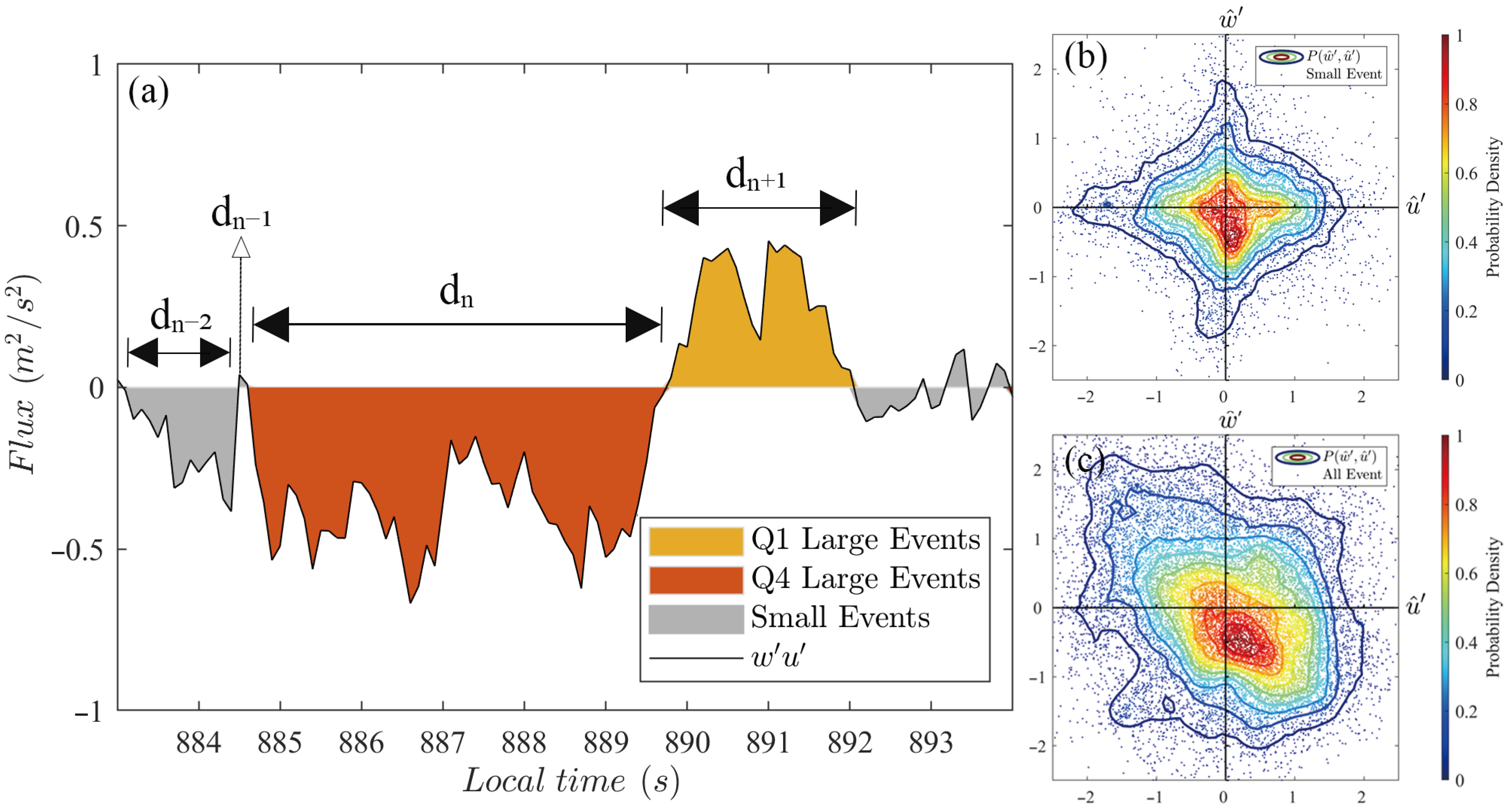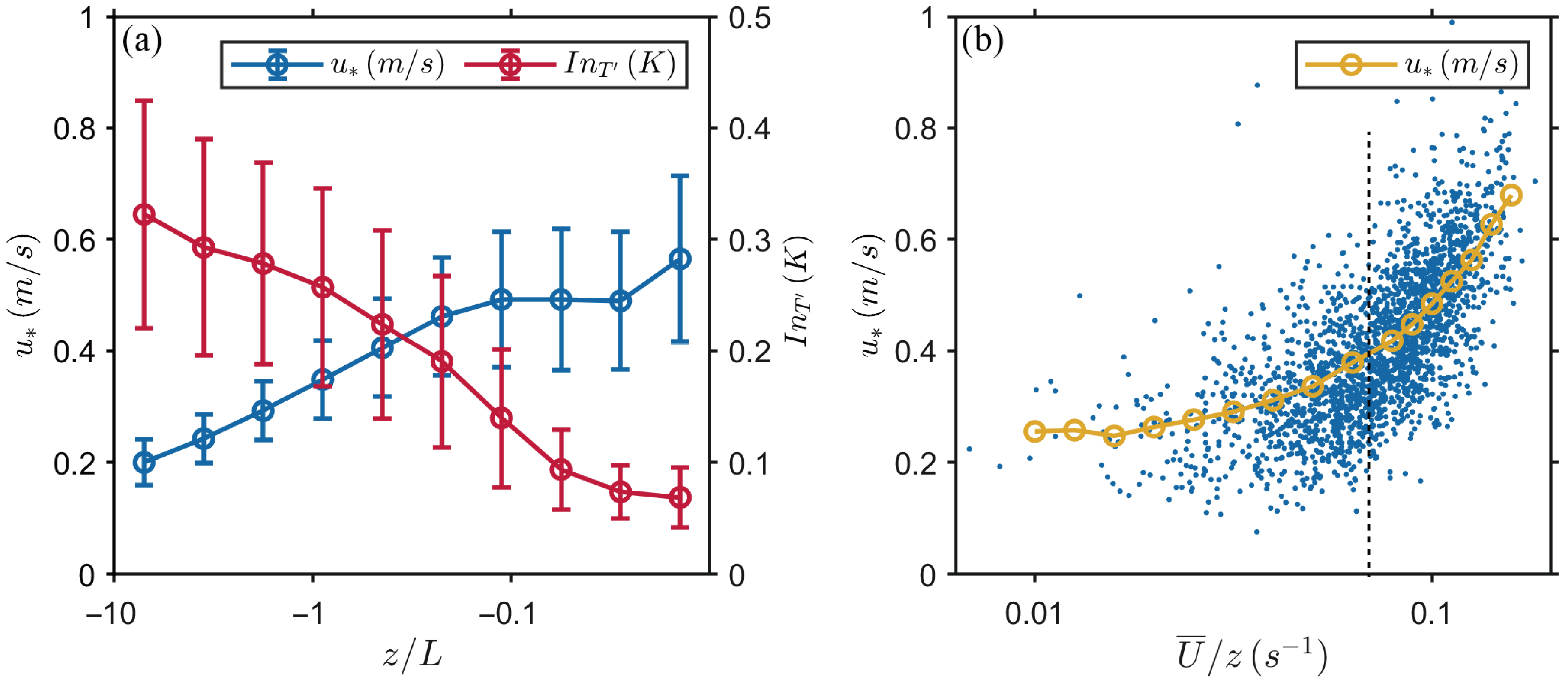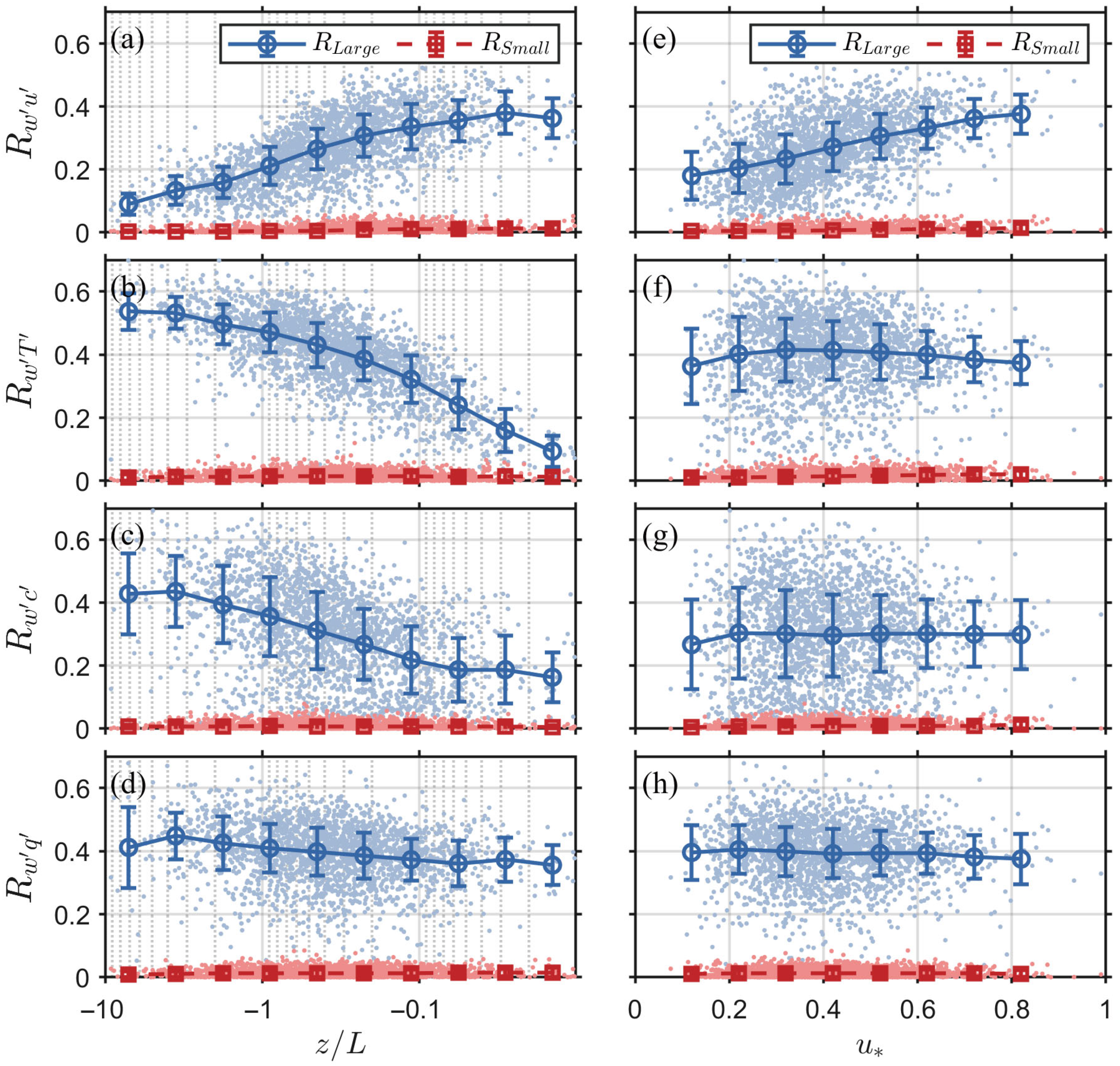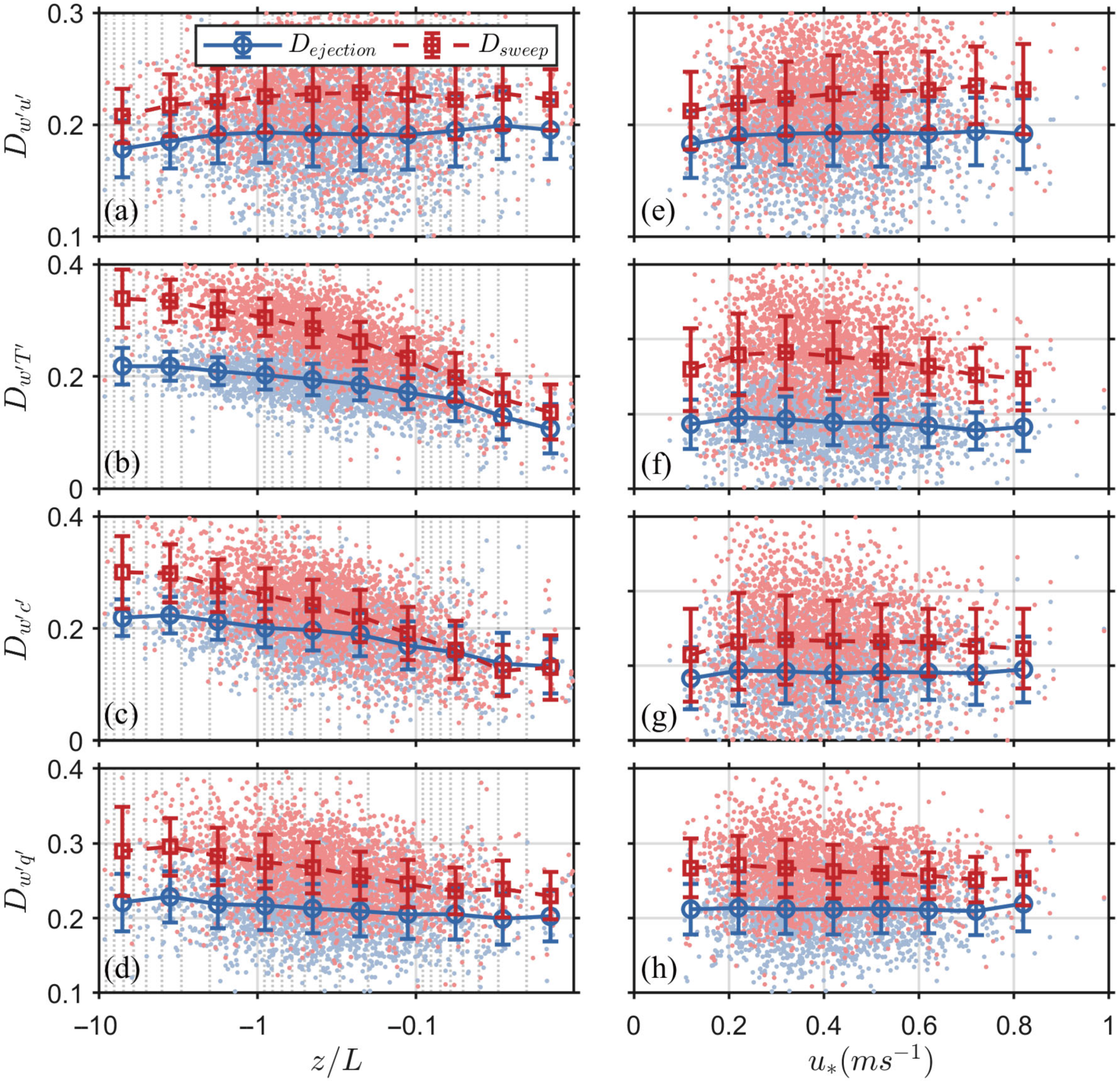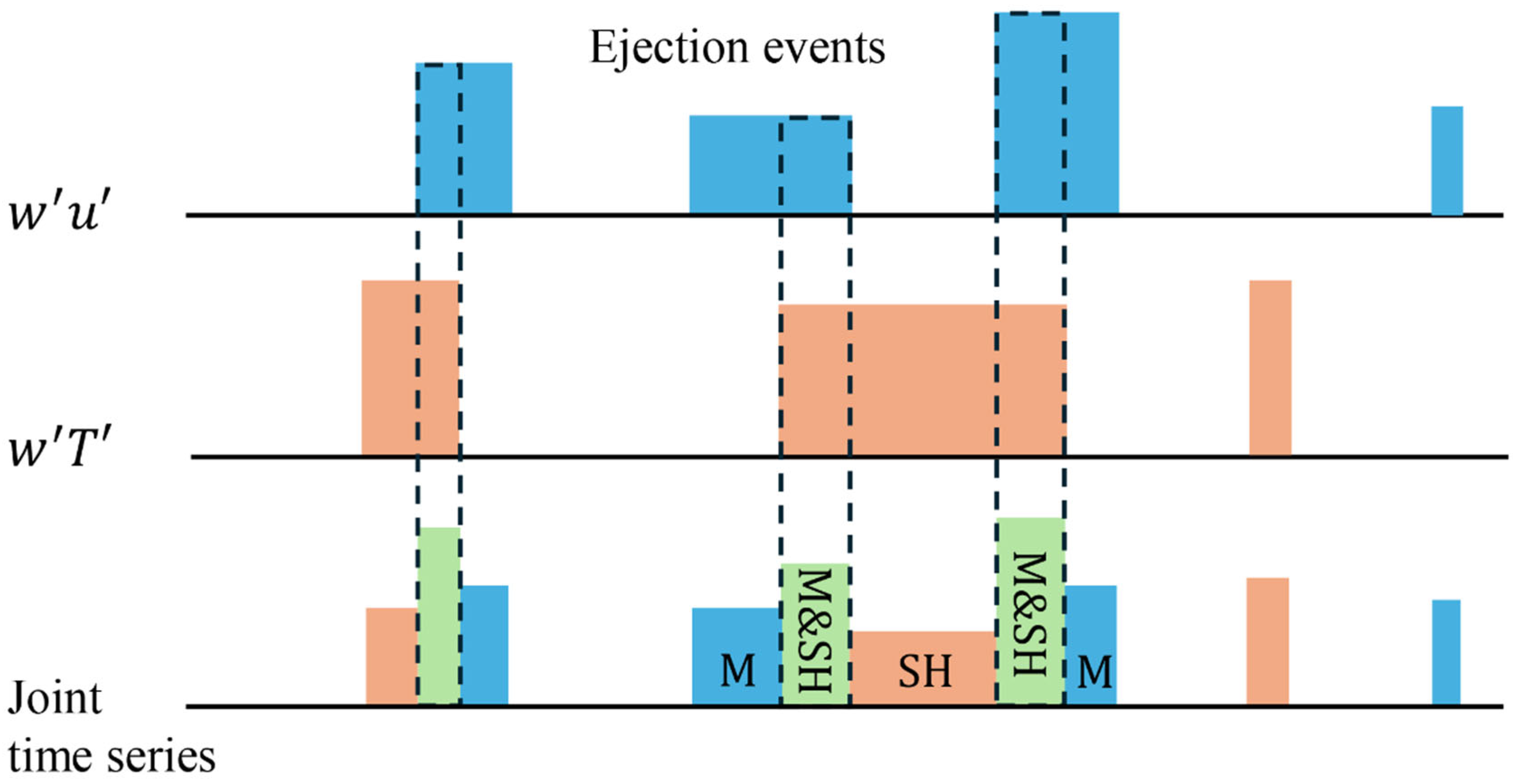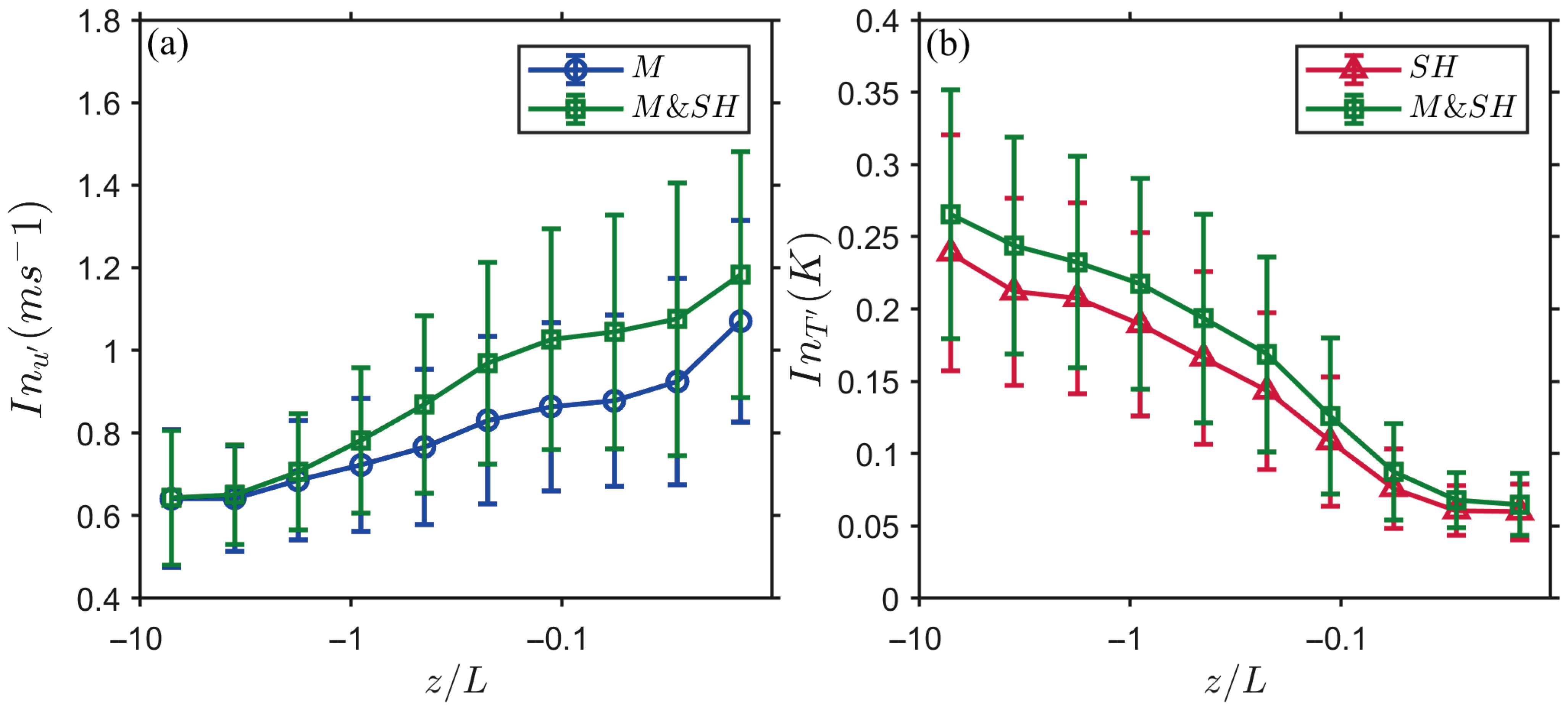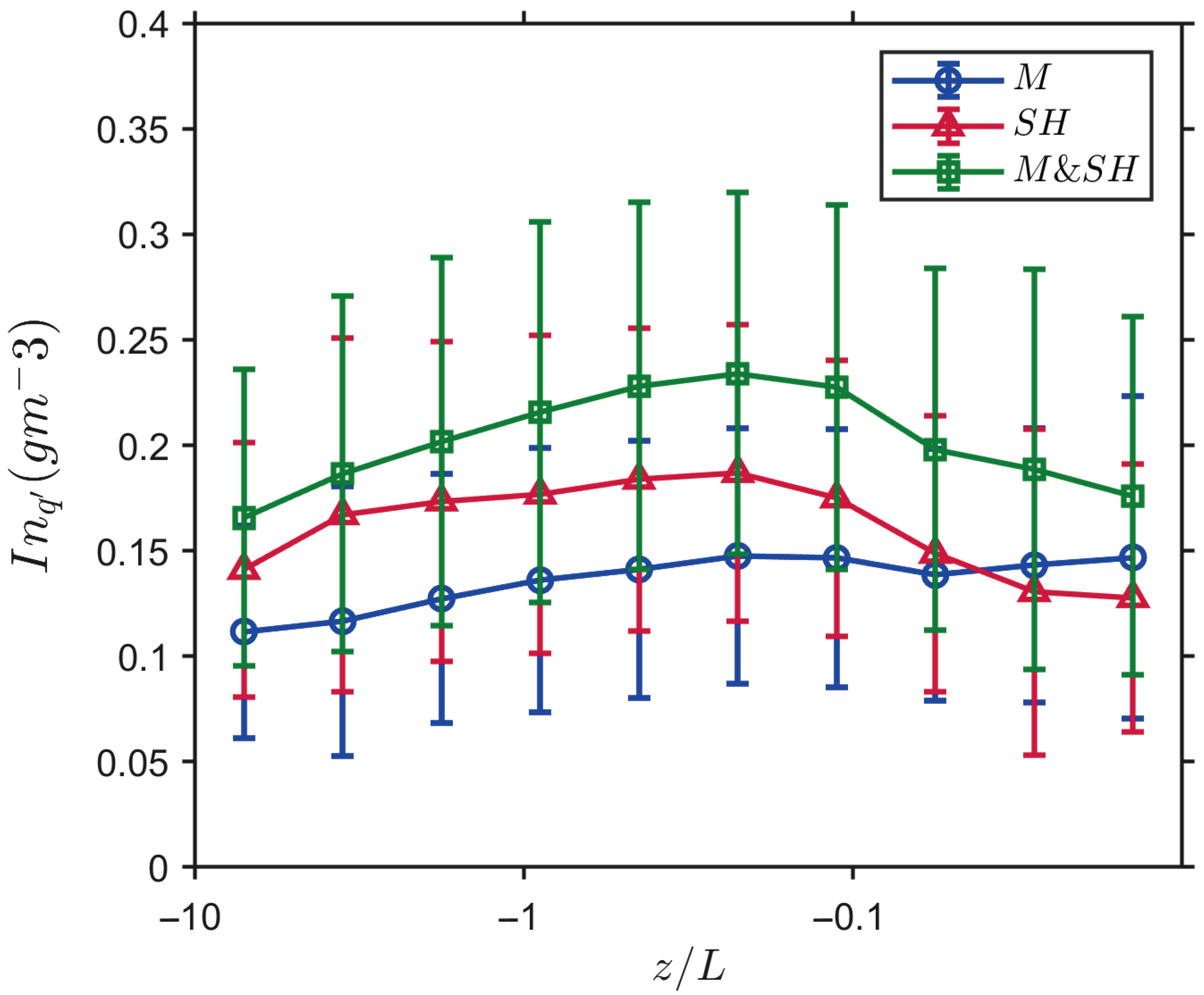3.1. Transport Dissimilarity of Large Eddy Events
It is crucial to understand the mechanism of turbulence generation and scales of turbulence eddies in an unstable ABL, because these factors significantly influence the energy and flux transport associated with large flux events and coherent structures.
Wind shear-driven mechanical turbulence and buoyancy-driven thermal turbulence are represented by
and temperature fluctuation intensity
, respectively, to quantify the contributions of wind shear and buoyancy under different stability conditions, as shown in
Figure 4a. Note that
represents the half-hour intensity of momentum flux observed at the measurement height
, and it should not be confused with friction velocity, which would typically be observed near the surface. The fluctuation intensity
is calculated as the mean value of the fluctuations during half-hour large ejection and sweep motions. The relationship between
(turbulence kinetic energy-related variables) and mean wind speed
is shown in
Figure 4b.
In
Figure 4a, under neutral conditions, the intensity of
is significantly higher, while the temperature fluctuation intensity is weak, reflecting strong wind shear and weak buoyancy. In contrast, under unstable conditions,
weakens and
enhances, indicating the dominant influence of buoyancy.
In
Figure 4b, under low wind conditions, the dependence of
on
is minimal. However, as the wind speed increases,
exhibits a linear relationship with
under strong wind conditions. The pattern of
as a function of
resembles the shape of a hockey stick, consistent with the findings of Sun et al. [
20]. The large
associated with bulk wind shear (
) corresponds to the large
under near-neutral conditions, as shown in
Figure 4a. As stability approaches neutral conditions,
increases linearly with bulk wind shear. This linear relationship between
and bulk wind shear under strong wind conditions indicates the dominant influence of bulk wind shear in generating large, nonlocal eddies comparable in scale to the observation height [
20]. Sun et al. [
20] found that bulk wind shear (
), rather than local vertical shear (
), predominates in turbulence generation under neutral conditions, and these nonlocal large eddies significantly enhance the vertical transport of momentum and heat.
To further investigate the influence of buoyancy and wind shear on the transport of large turbulent events, we apply the quadrant analysis with a threshold
to distinguish the large structures in the quadrants. These events contributed substantially to the overall flux, as shown in
Table 1, despite occupying a relatively small fraction of the total time. The transfer efficiencies of the large and small events are characterized by calculating the correlation coefficients as follows:
where
and
are the standard deviations of the vertical velocity
and the turbulent component
, respectively.
represents the absolute value of the correlation between
and
.
denotes the mean flux from events with a duration
, whereas
represents the mean flux from events with
.
Figure 5 illustrates the variations in the transfer efficiencies as a function of
and
. The transfer efficiencies of large events (
) are significantly higher than those of small events (
), indicating that the large events play a crucial role in the flux transport and effectively represent dominant eddies.
For momentum flux (
Figure 5a,e), the correlation coefficients increase with stability approaching the neutral condition and with enhanced wind shear, suggesting that momentum flux transport is largely governed by wind shear intensity. In contrast, for heat flux (in
Figure 5b),
is significantly influenced by the buoyancy-driven vertical motions under unstable conditions, whereas it decreases as buoyancy diminishes in neutral conditions. For passive scalars (water vapor and carbon dioxide), the correlation coefficients are also sensitive to buoyancy changes. However, in
Figure 5f–h, correlation coefficients are insensitive to
changes. The reason for this might be that the calculation reflects the correlation between
and
rather than the absolute magnitude of the flux. As
increases under near-neutral conditions,
increases alongside the enhancement of vertical mixing, while the intensity of
decreases and the standard deviation of
decreases, as shown in
Figure 4a. This might lead to a stable correlation between
,
, and
.
The observed decrease in the scalar flux transfer efficiencies as the stability approaches neutral conditions contrasts sharply with the increasing trend observed in the momentum flux. Similarly, the near-flat trend in scalar flux transfer efficiencies when wind shear intensifies is unlike the rising trend in the momentum flux transfer efficiencies. These dissimilarities between the scalars and momentum transport, which are consistent with the findings of Li and Bou-Zeid [
3] and Schmutz and Vogt [
7], highlight the influence of turbulent generation mechanisms under unstable conditions. Buoyancy primarily drives scalar transport, whereas wind shear enhances momentum transport.
Scalar transport related to the same eddies often exhibits different fluctuations owing to the independent sources and sinks of each scalar. To characterize the transport similarity between momentum, heat, and passive scalars, according to Li and Bou-Zeid [
3], the correlation coefficients between
and
are calculated as
where either
and
can be the turbulent fluctuating component
,
and
represents the standard deviations of
and
, respectively.
is the original flux time series, and
is the average flux of the 30 min period.
As shown in
Figure 6a, under unstable conditions (
), the correlation coefficients between the momentum and sensible heat fluxes are insignificant where turbulent motions are driven primarily by buoyancy and mechanical wind shear is relatively weak. The transport of momentum and passive scalars (
and
) is poorly correlated. The similarities between sensible heat and passive scalar transport are high (approximately 0.75), indicating that thermally driven turbulence predominates in the passive scalar transport under unstable conditions.
At the transition state between very unstable and neutral conditions (), the momentum–heat transport is partially correlated, with absolute approximately 0.4, where both buoyancy and wind shear affect the generation of large eddies.
Under near-neutral conditions (
), bulk wind shear becomes significant, and the transport similarity between momentum and passive scalars increases, with
approximately 0.5 under neutral conditions. In
Figure 6b, when the
is high, the nonlocal large eddies generated by bulk wind shear significantly enhance the vertical turbulent mixing, increasing the transport similarities between momentum, heat, and passive scalars [
8,
22]. The nonlocal mixing of sensible heat flux weakens the temperature gradient, resulting in reduced buoyancy and a lower correlation between the momentum and sensible heat under near-neutral conditions. Moreover, the similarities between the sensible heat and passive scalars decrease as the influence of buoyancy diminishes. Under neutral conditions, the correlation coefficient of
is larger than
, indicating that sensible heat and
are more strongly correlated than
, since water vapor positively affects buoyancy. Additionally, the passive scalars are better correlated with the sensible heat flux (max
around 0.75 under unstable conditions) than with the momentum flux (max
around 0.5 under neutral conditions), indicating that buoyancy-driven turbulence transports passive scalars more efficiently than mechanically driven eddies.
Note that
has different profiles under neutral conditions in this dataset, owing to the different sinks and sources at 50 m height, which will be further discussed in
Section 3.2. The general correlation coefficients results are consistent with those of prior studies [
3,
7,
23], except for
-related calculation under neutral conditions.
3.2. The Ejection and Sweep Behaviors Under Different Generation Mechanisms
To better understand how buoyancy and wind shear affect the flux transport dissimilarity, the ejections and sweeps are considered in separate calculations to characterize the impact of different turbulent generation mechanisms on the flux transport of large eddies. The intensity and duration of ejections and sweeps from large events selected by the threshold
are calculated. The intensity is calculated as the mean value of the fluctuations during the ejection and sweep motions, as shown in
Figure 7.
In
Figure 7a–d, the trends in
-wind and scalar intensities vary distinctly with stability. The
-wind intensity exhibits an increasing trend towards neutral conditions, where wind shear dominates the generation of turbulence. In contrast, sensible heat and
intensities show decreasing trends owing to the lack of buoyancy and thermal gradients.
, on the other hand, displays a trend that first increases and then decreases, indicating that the water vapor transport is influenced by both buoyancy and mechanically driven turbulence. These divergent behaviors between momentum and scalars are consistent with the flux transfer efficiencies shown in
Figure 5, indicating that buoyancy and wind shear play different roles in influencing the intensity of large eddies in turbulent transport.
For the scalars, as shown in
Figure 7b–d, the ejection intensity is higher than the sweep intensity under unstable conditions. This ejection–sweep asymmetry is caused by updrafts driven by buoyancy. When buoyancy diminishes and wind shear predominates in generating large eddies under neutral conditions, the well-mixed mechanical turbulent transport results in similar intensities of scalar ejections and sweeps.
For the
-wind, as shown in
Figure 7a, the difference between ejection and sweep intensities are largely independent of stability changes, suggesting that buoyancy has no significant influence on
wind intensity. In contrast, as shown in
Figure 7e, the difference between ejection and sweep intensity increases as the wind shear strengthens, whereas the gap between the scalar ejection and sweep decreases as
increases, as shown in
Figure 7f–h.
Unlike the dissimilar trends between -wind and the scalar intensities in the left panels, the increasing trends in all four fluctuations in the right panels highlight the dominant role of wind shear in enhancing large-eddy transport.
In conclusion, buoyancy significantly enhances the scalar ejection intensity, while wind shear boosts both ejection and sweep intensities in large eddies.
The mechanisms of large eddies can also be reflected in the durations of the ejection and sweep motions. Combined with the analysis of the flux-respective intensities in the previous discussion, the duration analysis offers deeper insights into the contributions of buoyancy and wind shear to transport processes in turbulent flow.
The durations
of the momentum and scalar fluxes are determined by measuring the duration of large events occurring in the ejection and sweep quadrants, as shown in
Figure 8. Under unstable conditions, as shown in
Figure 8a, the variation in buoyancy has little effect on the momentum ejections and sweeps. The updrafts induced by buoyancy result in longer ejection durations for scalars (
Figure 8b–d), highlighting the significant role of buoyancy in scalar flux transport. Sweep motions typically have longer durations than ejections, although ejections contribute more flux than sweeps [
23], indicating that ejections are more efficient in transporting flux. Under neutral conditions, where buoyancy effects diminish, the ejection and sweep durations for the scalars tend to converge.
In
Figure 8e–h, the durations of momentum and scalar ejections and sweeps are insensitive to changes in
. This indicates that mechanically driven turbulence has minimal influence on the duration of ejections and sweeps but enhances their flux intensity, as shown in
Figure 7e–h. In contrast, buoyancy-driven turbulence affects both the duration and intensity of scalar ejections and sweeps. Under unstable conditions, buoyancy effects create more ejection and sweep motions, contributing to scalar flux transport.
The skewness of
, and
are shown in
Figure 9, illustrating the positive or negative deviations from the means of these fluctuations, specifically updrafts vs. downdrafts. For scalar fluctuations, absolute skewness values are larger under unstable conditions, indicating stronger updrafts than downdrafts. This asymmetry in ejections and sweeps is consistent with the patterns observed in
Figure 7. The positive skewness of
and
under unstable conditions suggests that the buoyancy supports the warm and moist updrafts, corroborating findings of Li and Bou-Zeid [
3]. Under neutral conditions, the scalar skewness values approach zero, reflecting well-mixed scalars and a more balanced ejection–sweep structure under strong wind shear. The skewness of
changes its sign under neutral conditions, indicating that the nonlocal vertical mixing driven by bulk wind shear introduces nonlocal sinks and sources and affects the
gradient at 50 m height.
In contrast to scalar fluctuations, the skewness of
-wind increases with enhanced wind shear, whereas
-wind skewness remains near zero under unstable conditions. The skewness of
is consistently positive and decreases slightly under neutral conditions, but is insensitive to changes in
. This indicating that updrafts driven by both buoyancy and wind shear are stronger than downdrafts, and that ejection motions play a crucial role in turbulent transport. Wind shear predominantly enhances the asymmetry of
-wind towards negative values, whereas
-wind asymmetry remains positive, highlighting intensified ejection motions. As shown in
Figure 8e, the duration of the ejection events is insensitive to
, suggesting that the efficiency of ejection flux transport is significantly enhanced.
3.3. The Solo and Joint Flux Transport Between Momentum and Sensible Heat Fluxes
In this section, the influence of buoyancy and mechanically driven turbulence on flux transport is further investigated by analyzing the independent and synchronized transport of momentum and sensible heat flux. In a half-hour run, the momentum and heat ejections and sweeps in the time series can be classified as the solo transport of momentum (
), the solo transport of sensible heat (
), and their joint transport (
), as shown in
Figure 10.
In
Figure 10, the ejection events on the joint time series are split into segments of solo flux (momentum or sensible heat) and joint transport between these fluxes. Every ejection or sweep event from momentum or sensible heat is compatible with these flux transport states. The durations of solo and joint flux transport are calculated as follows:
where
represents the occurrence of solo momentum transport in the ejection and sweep events, and
(sensible heat transport) and
(joint transport) are calculated similarly. In this section, ejections and sweeps are calculated as a whole because of their similar trends and sensitivities to stability changes.
As shown in
Figure 6, the correlation coefficients between the momentum and sensible heat fluxes are relatively low under very unstable or neutral conditions, which matches the long duration for solo heat transport under unstable conditions and long duration for solo momentum transport under neutral conditions. These findings indicate that solo flux transport plays a significant role in influencing momentum and sensible heat dynamics.
Under unstable conditions (
), as shown in
Figure 11, the duration of solo sensible heat transport is equivalent to the joint transport of momentum and sensible heat fluxes and is significantly longer than the solo momentum transport. This indicates that thermal plumes and buoyancy generated large eddies that facilitate the joint transport of momentum and heat, whereas the mechanically driven turbulence is weak. Under neutral conditions, bulk wind shear weakens the temperature gradient, reducing the sensible heat flux transport while increasing momentum flux transport. The reduced temperature gradient also lowers buoyancy and diminishes heat flux-related transport activities, including both solo sensible heat flux and joint flux transport.
During the transition state between very unstable and neutral conditions (), the solo sensible heat flux transport steadily declines as stability increases, indicating that the thermal gradient force continuously decreases. Near , the duration of solo momentum transport exceeds that of the solo sensible heat flux transport. This reflects the more frequent occurrence of mechanically driven turbulence compared with buoyancy-driven turbulence, indicating that wind shear plays a dominant role over buoyancy.
The relatively flat trend in the joint flux transport under unstable conditions might be explained by the offsetting effects of increasing shear-generated turbulence and decreasing buoyancy. The near-flat trend in the solo momentum transport indicates that most of the mechanically generated turbulence develops locally [
8,
21]. As wind shear is enhanced under unstable conditions, local mechanical turbulence activities are primarily generated within buoyancy-driven structures, such as thermal plumes. Another way to understand this is that buoyancy predominates in the surface layer, where the most turbulent changes occur under its influence. This development also increases the co-transport with sensible heat flux, corroborating the increasing momentum–heat transport similarity under the transition state shown in
Figure 6. The increase–decrease offsetting and local developing result in a steady duration for co-transport events despite stability changes.
A noticeable slope change in solo momentum transport under near neutral conditions () indicates the significant development of nonlocal mechanically generated turbulence as wind shear continuously enhances. As the local mechanically driven turbulence becomes nonlocal, the structural stability of local thermal plumes diminishes, resulting in a decrease in the occurrence of joint flux transport occurrence events.
The average fluctuation intensities of
and
during solo and joint transport process are calculated and are shown in
Figure 12. The
intensity increases as the wind shear increases, whereas
intensity decreases as buoyancy diminishes.
Under neutral conditions, the lack of strong buoyancy forces indicates that both solo heat and joint transport events are influenced similarly by wind shear, leading to similar fluctuation intensities of . Under unstable conditions, the strong vertical motions driven by buoyancy leads to similar intensities for the solo and co-transport events.
The intensity of joint transport is higher than that of solo transport. Under near-neutral conditions, the combined transport of momentum and heat driven by wind shear is more efficient in turbulent mixing and transport, leading to high velocity fluctuation intensities during joint transport events. Under unstable conditions, co-transport events benefit from the combined effects of buoyancy and wind shear, resulting in high temperature fluctuation. Solo sensible heat flux transport shows low intensities owing to the lack of this synergistic effect.
The slope of the fluctuation intensity
during joint transport increases faster than that during momentum transport under unstable conditions (
), as shown in
Figure 12a. This indicates that local mechanically driven turbulence is more developed within buoyancy-driven structures than when influenced solely by wind shear. This finding aligns with the previous discussion, in which local mechanically driven turbulence is primarily generated with buoyancy-driven structures. Under near-neutral conditions (
), the increasing trends in solo and joint transport become similar, indicating that nonlocal shear-generated turbulence predominates the solo and joint flux transport. Conversely, for
intensity, a similar decreasing trend in both solo and joint flux transport under unstable conditions reflects the dominant role of buoyancy despite its decrease.
The dynamics between these mechanisms can be further investigated using passive scalars. The fluctuation intensity of
in solo and joint transport is calculated, as shown in
Figure 13. Note that
intensity is not discussed here because of its different profile compared to those in prior studies, as shown in
Figure 9.
Under unstable conditions, buoyancy dominates transport, leading to higher fluctuation intensities during joint transport and solo heat transport than during solo momentum transport. In joint transport events, is under the combined influence of wind shear and buoyancy, resulting in high intensities.
Under near-neutral conditions, the intensities during solo momentum transport are higher than those during solo heat transport, indicating the dominant role of shear-generated turbulence. The correlation between
and momentum fluxes is significantly lower than that between
and sensible heat, as shown in
Figure 6. Additionally,
has a positive effect on buoyancy [
7]. This results in small intensity differences between the solo momentum and solo heat transport. In joint transport events, turbulent mixing is more effective for transporting both momentum and heat fluxes, leading to the high transport efficiency of
.
A noticeable slope change can be found near
, where wind shear and buoyancy are equally matched, resulting in the highest intensity of
during joint transport events, which is consistent with the intensity result from
Figure 7d. Under unstable conditions, the
intensity during the solo heat flux transport increases as the stability approaches neutral conditions. In the discussion in
Section 3.1, the reason for the increasing trend under unstable conditions is the combined influence of wind shear and buoyancy. When only the influence of buoyancy is considered, this may be explained by the fact that, under very unstable conditions, low wind speed and high temperature gradients cause rapid water loss from plants, prompting them to close their stomata to conserve water. Therefore, the decrease in plant transpiration and photosynthesis weakens water vapor gradient and transport. As the wind shear increases and thermal gradient weakens, the evaporation rate from the plants increases. The dissimilarity changes between the sources and sinks of heat and water vapor results in different vertical turbulent transport, corroborating the results of previous studies [
9,
11,
16,
28].
